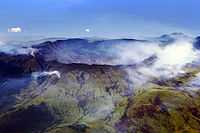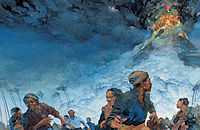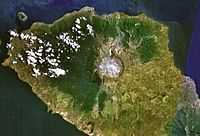Volcanoes/Mount Tambora
< Volcanoes
1815 was the "Great Eruption" of Mount Tambora, Indonesia.
Great Eruption

On April 10, 1815, Mt. Tambora triggered an explosive eruption. Not only did it explode volcanic ash, but Pumice rocks and volcanic ash have flown shooting out 150 cubic km of pyroclastic material (volcanic ash). Two to three days after the eruption, the atmosphere produced pitch darkness - no light from the sun whatsoever for an area covering 375miles/ 600 km from Tambora. The area that was blanketed in ash is also currently approximately the distance from the drive from Boston to Wichita, Kansas. This was one of the largest known ash-producing eruptions in the last 10,000 years, so they called this event the “Great Eruption”. The Great eruption reduced the volcano to half its former size. Tambora is still a large stratovolcano (2860 m tall and 1000 km3 in volume) located on the Indonesian island of Sumbawa (part of the Lesser Sunda Islands).
Location

Mount Tambora is centered in the image on the right on the Sumbawa Island, (Southern) Indonesia. Sumbawa Island is east of Bali and Colombo. Sumbawa Island is made up of hundreds of small islands in this area including the two major ones. It is largely mountainous with rocky coasts and a few small plains. Latitude: S. 8° 15’ Longitude: E. 118° 0’.
Aftermath
The “Great Eruption” caused the years of 1815-1816 known as the “Year(s) without a summer”. The effect of the “Great Eruption” produced a drop in average global temperature between 0.4 - 0.7° Celsius, while warming the atmosphere by as much as 15 Kelvin. Mount Tambora caused a prodigious transaction or turmoil and mayhem:
- Crop failures- famine
- Acid fogs, cold winters, penetrating sunsets
- Haze through the Northern hemisphere: as far as London, Russia, the US, and beyond
- Dreary summers/ extreme weather in the spring and summertime
Global Human Impact
Of the island of Sumbawa’s 12,000 inhabitants, only 26 survived. In addition continuous, frequent earthquakes, pyroclastic flows and tsunamis associated with the event initiated fatalities with an estimate of about 92,000 deaths. The 92,000 deaths occurred in just a few days. The ash polluted water supply and the atmosphere full of ash and volcanic gases. Rapidly, famines and disease extended across the province and the exact number of deaths will never be known.
In Europe, the summer of 1816 was cool and exceedingly wet. Immense crop failures led to famines, disease, and social turmoil. In central England, the temperature was about 1.5°C cooler than during the summer of 1815. Typhus (a bacterial disease spread by lice or fleas) was reported in almost every town and village in England, and was reported in many cities throughout Scotland. In Ireland, approximately 800,000 people were infected during the typhus epidemic, because of that, 4,300 perished from the mutual devastation of famine, dysentery, and fever. Somewhere else in Europe, the summer of 1816 was also recorded to be one of the most miserable winters in contemporary history.
In the US, 1816 was marked by a persistent dry fog, or dim sun, as reported in the northeastern United States. According to a report from New York, the atmospheric pollution reddened and dimmed the sun so much that sunspots were visible to the naked eye. Unusually, the total lunar eclipse on June 9th-10th was also testified to be extremely darker than normal. The summer of 1816 was the coldest in New Haven, Connecticut, with frosts! The next day, a cold front gripped most of New England. Severe frosts had spread city to city and state to state. Conditions continued over the next 3 months, which reduced the growing season and resulted in almost total failure of main crops.
Canada also experienced severe weather and the same cold wave that hit New England. There was snow falling in the beginning of June. Unlike the British Isles and North America, Canada did not go through serious distresses (due to their full resources).
Research
Hypothesis:
- The eruptions of Mount Tambora have been decreasing over the millenia.
Control groups

The findings demonstrate a statistically systematic change from the status quo or the control group.
“In the design of experiments, treatments [or special properties or characteristics] are applied to [or observed in] experimental units in the treatment group(s).[1] In comparative experiments, members of the complementary group, the control group, receive either no treatment or a standard treatment.[2]"[3]
Proof of concept
Def. a “short and/or incomplete realization of a certain method or idea to demonstrate its feasibility"[4] is called a proof of concept.
Def. evidence that demonstrates that a concept is possible is called proof of concept.
The proof-of-concept structure consists of
- background,
- procedures,
- findings, and
- interpretation.[5]
See also
Bibliography
- http://www.universetoday.com/31840/mount-tambora/
- http://www.hawaii247.com/2011/09/29/volcano-watch-infamous-mount-tambora-is-rumbling-again/
- http://www.earthobservatory.nasa.gov/IOTD/view.php?id=39412
- http://www.geolsoc.org.uk/page2972.html
- http://scienceblogs.com/eruptions/2009/04/194_years_since_the_great_tamb.php
- http://hilo.hawaii.edu/academics/hohonu/writing.php?id=137
- http://ngm.nationalgeographic.com/2008/01/volcano-culture/mount-tambora-photography
- http://www.wired.com/science/discoveries/news/2009/04/dayintech_0410
References
- ↑ Klaus Hinkelmann, Oscar Kempthorne (2008). Design and Analysis of Experiments, Volume I: Introduction to Experimental Design (2nd ed.). Wiley. ISBN 978-0-471-72756-9. http://books.google.com/?id=T3wWj2kVYZgC&printsec=frontcover.
- ↑ R. A. Bailey (2008). Design of comparative experiments. Cambridge University Press. ISBN 978-0-521-68357-9. http://www.cambridge.org/uk/catalogue/catalogue.asp?isbn=9780521683579.
- ↑ "Treatment and control groups, In: Wikipedia". San Francisco, California: Wikimedia Foundation, Inc. May 18, 2012. Retrieved 2012-05-31.
- ↑ "proof of concept, In: Wiktionary". San Francisco, California: Wikimedia Foundation, Inc. November 10, 2012. Retrieved 2013-01-13.
- ↑ Ginger Lehrman and Ian B Hogue, Sarah Palmer, Cheryl Jennings, Celsa A Spina, Ann Wiegand, Alan L Landay, Robert W Coombs, Douglas D Richman, John W Mellors, John M Coffin, Ronald J Bosch, David M Margolis (August 13, 2005). "Depletion of latent HIV-1 infection in vivo: a proof-of-concept study". Lancet 366 (9485): 549-55. doi:10.1016/S0140-6736(05)67098-5. http://www.ncbi.nlm.nih.gov/pmc/articles/PMC1894952/. Retrieved 2012-05-09.
External links
![]() This is a research project at http://en.wikiversity.org
This is a research project at http://en.wikiversity.org
| |
Development status: this resource is experimental in nature. |
| |
Educational level: this is a research resource. |
| |
Resource type: this resource is an article. |
| |
Resource type: this resource contains a lecture or lecture notes. |
| |
Subject classification: this is a Geology resource. |